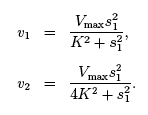Hill Equation Problem 3
Tutorial to help us answer problem 3.
To understand the relationship between velocity and substrate concentration for an enzyme with a Hill coefficient of 2, we first rewrite the Hill equation for n = 2 states as follows,

If we let [S] = s1, where s1is an arbitrary concentration, we can find V as,

Now we want to know what happens to V if the substrate concentration is halved. Mathematically, we can express this as s2 = s1/2. To understand this, we use the Hill equation as,

We now want to see if there is a simple way that v2 relates to v1 because this will tell us how halving the substrate concentration has changed the velocity (e.g. v2 = 2v1). To clear the compound fraction in v2, we multiply the numerator and denominator by 4 to get,

Now compare this expression to v1,

Notice that v2 ≠ 1/4v1 because the constant 4 is not being multiplied by the entire denominator, i.e. ![]() because
because![]() . In fact, there is no constant c such that v2 = cv1.
. In fact, there is no constant c such that v2 = cv1.
Convince yourself this is true by setting v2 = cv1 and try to solve for c. You will not be able to find c as a constant. Therefore, halving the substrate concentration does no alter the velocity in a simple linear fashion.